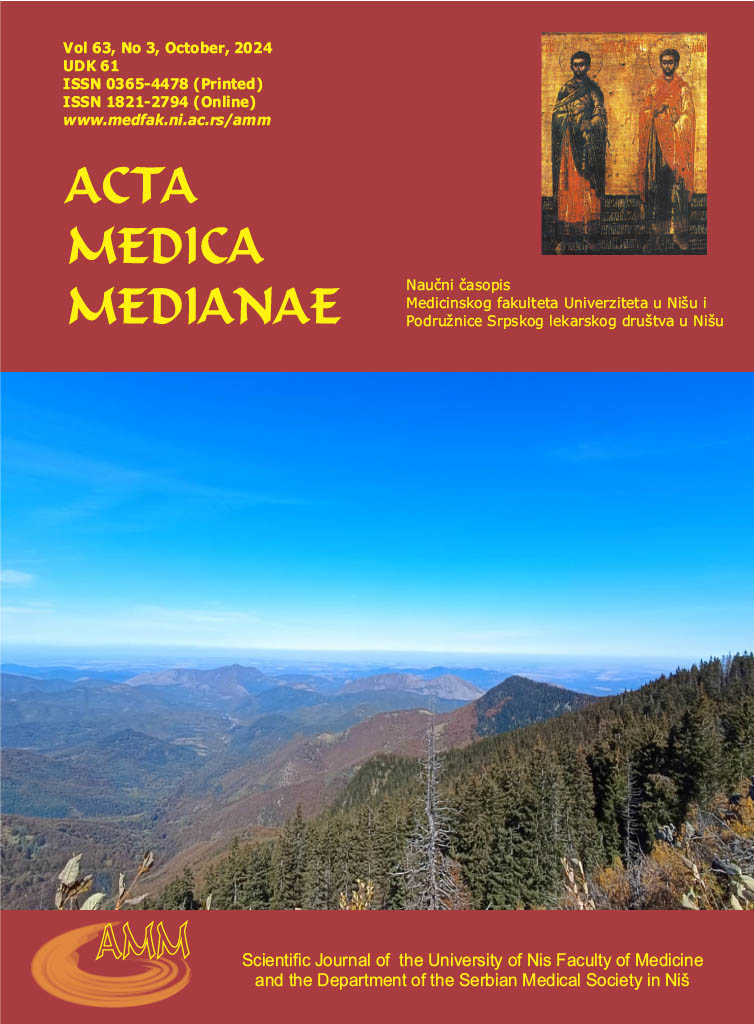TROVANJA ŽENA LEKOVIMA U TOKU PANDEMIJE COVID-19 U JUGOISTOČNOJ SRBIJI
Sažetak
Lekovi su drugi na listi uzročnika smrtnosti povezane sa trovanjima i prvi na listi uzročnika trovanja. U proseku, jedna od četiri osobe na svetu razvije neki oblik mentalne bolesti u toku života. Pandemije, poput pandemije virusa korona 2019 (COVID-19), imaju kratkoročne, ali i dugoročne efekte na mentalno zdravlje i važan uticaj na društveni život. Trenutno nema podataka o trovanjima lekovima u toku pandemije COVID-19 na jugoistoku Srbije, pa je analiza ovog fenomena bila neophodna. U te svrhe sprovedena je retrospektivna studija preseka za period od marta 2020. do marta 2022. godine. Korišćeni su podaci toksikološke laboratorije Zavoda za sudsku medicinu u Nišu. Od 310 slučajeva intoksikacije bilo je 59,35% zabeleženih u ženskoj populaciji. Najveći broj slučajeva u ženskoj populaciji primećen je u kategoriji žena starih od 12 do 19 godina (75%). Među onima koji su imali više od 51 godine broj trovanja bio je 2,17 puta veći kod žena. Prilikom posmatranja kategorije osoba starih od 12 do 19 godina primećen je najveći broj trovanja sedativima, analgeticima i antiepilepticima. Najčešći uzročnici trovanja u populaciji koja ima više od 51 godine bili su sedativi, lekovi za lečenje kardiovaskularnih bolesti, antiepileptici i antidepresivi. S obzirom na ove rezultate, može se reći da žene u periodu adolescencije i žene starije od 51 godine treba da budu ciljna grupa prilikom edukacija i podizanja svesti o mentalnom zdravlju.
Propisivanje sedativa uvek treba pažljivo razmotriti budući da se ova grupa lekova najčešće koristi za trovanje.
Reference
Althobaiti BM, El-Readi MZ, Althubiti M, Alhindi YZ, Alzahrani AR, Al-Ghamdi SS, et al. Patterns of acute poisoning for children during outbreak of Corona virus in Makkah region Saudi Arabia. Front Pediatr 2023; 11:1087095. [CrossRef] [PubMed]
Chrzanowska A, Man N, Darke S, Degenhardt L, Farrell M, Moran L, et al. Unintentional and intentional drug poisoning deaths, Australia, 2012–2016: Drug pattern profile and demographic characteristics. Drug Alcohol Depend 2021; 229(Pt B):109112. [CrossRef] [PubMed]
Dayasiri K, Jayamanne SF, Jayasinghe CY. Accidental and Deliberate Self-Poisoning with Medications and Medication Errors among Children in Rural Sri Lanka. Emerg Med Int 2020;2020:9872821. [CrossRef] [PubMed]
Descamps AMK, Vandijck DM, Buylaert WA, Mostin MA, Paepe PD. Characteristics and costs in adults with acute poisoning admitted to the emergency department of a university hospital in Belgium. PLoS One 2019;14(10):e0223479. [CrossRef] [PubMed]
Gong Y, Liu X, Zheng Y, Mei H, Que J, Yuan K, et al. COVID-19 Induced Economic Slowdown and Mental Health Issues. Front Psychol 2022; 13:777350. [CrossRef] [PubMed]
Haoka T, Sakata N, Okamoto H, Oshiro A, Shimizu T, Naito Y, et al. Intentional or unintentional drug poisoning in elderly people: retrospective observational study in a tertiary care hospital in Japan. Acute Med Surg 2019;6(3):252–8. [CrossRef] [PubMed]
Holmes EA, O’Connor RC, Perry VH, Tracey I, Wessely S, Arseneault L, et al. Multidisciplinary research priorities for the COVID-19 pandemic: a call for action for mental health science. Lancet Psychiatry 2020;7(6):547–60. [CrossRef] [PubMed]
Jonassen R, Hilland E, Harmer CJ, Abebe DS, Bergem AK, Skarstein S. Over-the-counter analgesics use is associated with pain and psychological distress among adolescents: a mixed effects approach in cross-sectional survey data from Norway. BMC Public Health 2021;21(1):2030. [CrossRef] [PubMed]
Kessler RC, Angermeyer M, Anthony JC, DE Graaf R, Demyttenaere K, Gasquet I, et al. Lifetime prevalence and age-of-onset distributions of mental disorders in the World Health Organization’s World Mental Health Survey Initiative. World Psychiatry 2007;6(3):168–76. [PubMed]
Khan TS, Boyle A, Talbot S. Unintentional Drug-related Deaths in Cambridgeshire: A Retrospective Observational Study. Cureus 2020;12(1):e6750. [CrossRef] [PubMed]
Kiang MV, Acosta RJ, Chen YH, Matthay EC, Tsai AC, Basu S, et al. Sociodemographic and geographic disparities in excess fatal drug overdoses during the COVID-19 pandemic in California: A population-based study. Lancet Reg Health Am 2022; 11:100237. [CrossRef] [PubMed]
Lee JS, Cha YS, Yeon S, Kim TY, Lee Y, Choi JG, et al. Changes in Diagnosis of Poisoning in Patients in the Emergency Room Using Systematic Toxicological Analysis with the National Forensic Service. J Korean Med Sci 2021;36(18):e118. [CrossRef] [PubMed]
Marcheselli F, Brodie E, Yeoh SN, Pearce N, McManus S, Sadler K, et al. Mental health of children and young people in England, 2017. London: NHS [Internet]. 2018;
Mbeledogu CNA, Cecil EV, Millett C, Saxena S. Hospital admissions for unintentional poisoning in preschool children in England; 2000–2011. Arch Dis Child 2015;100(2):180–2. [CrossRef] [PubMed]
McManus S, Bebbington P, Jenkins R, Brugha T. Mental Health and Wellbeing in England: the Adult Psychiatric Morbidity Survey 2014. McManus S, Bebbington P, Jenkins R, Brugha T, editors. 2016 [cited 2023 May 8];
Mégarbane B, Oberlin M, Alvarez JC, Balen F, Beaune S, Bédry R, et al. Management of pharmaceutical and recreational drug poisoning. Ann Intensive Care 2020;10(1):157. [CrossRef] [PubMed]
Mental health [Internet]. [cited 2023 May 8]. Available from: https://www.womenshealth.gov/mental-health
Nistor N, Jitareanu C, Frasinariu OE, Ciomaga IM, Rugina AL, Streanga V. Epidemiologic profile and triggering factors of voluntary poisoning in teenagers. Medicine 2017;96(5) :e5831. [CrossRef] [PubMed]
Saitz R, Horton NJ, Samet JH. Alcohol and medication interactions in primary care patients: common and unrecognized. Am J Med 2003;114(5):407–10. [CrossRef] [PubMed]
Stanca S, Bostan I, Stanca HT, Danielescu C. Updates in teenage acute intentional self-poisonings. Romanian [Internet]. 2021; Available from: http://eprints.bmsu.ac.ir/9559/1/Challenging%20of%20COVID-19%20crisis%20in%20the%20Emergency%20Department.pdf#page=114
Tyrrell EG, Orton E, Sayal K, Baker R, Kendrick D. Differing patterns in intentional and unintentional poisonings among young people in England, 1998–2014: a population-based cohort study. J Public Health 2016;39(2):e1–9. [CrossRef]
Women’s mental health facts [Internet]. Agenda Alliance. [cited 2023 May 8]. Available from: https://www.agendaalliance.org/our-work/projects-and-campaigns/womens-mental-health-facts/

